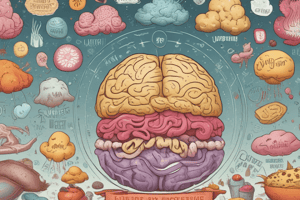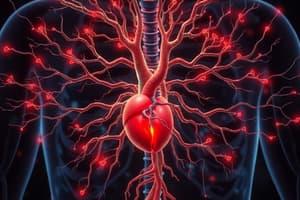Podcast
Questions and Answers
Which of the following peptides is classified as orexigenic?
Which of the following peptides is classified as orexigenic?
- Insulin
- Ghrelin (correct)
- CART
- Leptin
What is the effect of anorexigenic signals on energy expenditure?
What is the effect of anorexigenic signals on energy expenditure?
- Increase energy expenditure (correct)
- Increase food intake
- Increase energy storage
- Decrease energy expenditure
Which neuropeptide is argued not to be a neuropeptide but plays a role in appetite regulation?
Which neuropeptide is argued not to be a neuropeptide but plays a role in appetite regulation?
- Neuropeptide Y (NPY)
- Leptin (correct)
- Melanocyte Stimulating Hormone (αMSH)
- Ghrelin
What is the primary role of αMSH in the hypothalamus?
What is the primary role of αMSH in the hypothalamus?
How does fasting affect POMC gene expression?
How does fasting affect POMC gene expression?
Which receptor subtype is primarily associated with melanocortin in the brain?
Which receptor subtype is primarily associated with melanocortin in the brain?
What effect do orexigenic signals have on energy storage?
What effect do orexigenic signals have on energy storage?
Which peptide is considered anorexigenic and acts to reduce food intake?
Which peptide is considered anorexigenic and acts to reduce food intake?
What role do synthetic agonists play in food intake regulation?
What role do synthetic agonists play in food intake regulation?
Which receptor deletion is primarily associated with obesity in mice?
Which receptor deletion is primarily associated with obesity in mice?
What is the primary effect of Neuropeptide Y (NPY) when injected into the hypothalamus?
What is the primary effect of Neuropeptide Y (NPY) when injected into the hypothalamus?
What type of peptides are predominantly involved in anorexigenic signaling?
What type of peptides are predominantly involved in anorexigenic signaling?
Which substance causes long-lasting hyperphagia when administered intracerebroventricularly?
Which substance causes long-lasting hyperphagia when administered intracerebroventricularly?
What characterizes mice that lack NPY receptor subtypes Y1 or Y5?
What characterizes mice that lack NPY receptor subtypes Y1 or Y5?
Which of the following is considered to be orexigenic?
Which of the following is considered to be orexigenic?
Which neuropeptide is most abundant in the human brain?
Which neuropeptide is most abundant in the human brain?
What is the primary function of leptin in the context of energy balance?
What is the primary function of leptin in the context of energy balance?
Which of the following accurately describes the source of insulin in the body?
Which of the following accurately describes the source of insulin in the body?
Which neuropeptide is classified as orexigenic?
Which neuropeptide is classified as orexigenic?
What is a significant effect of neuronal deletion of the leptin receptor (Ob-Rb)?
What is a significant effect of neuronal deletion of the leptin receptor (Ob-Rb)?
What regulatory role does leptin NOT play in the body?
What regulatory role does leptin NOT play in the body?
Which peptide is produced exclusively in the hypothalamus rather than peripheral tissues?
Which peptide is produced exclusively in the hypothalamus rather than peripheral tissues?
Which statement about the effects of insulin in the hypothalamus is true?
Which statement about the effects of insulin in the hypothalamus is true?
Which biological function is primarily associated with leptin?
Which biological function is primarily associated with leptin?
Which peptide is primarily produced and secreted by the endocrine mucosal L-cells of the gastrointestinal tract?
Which peptide is primarily produced and secreted by the endocrine mucosal L-cells of the gastrointestinal tract?
What is the main action of Peptide YY (PYY 3-36)?
What is the main action of Peptide YY (PYY 3-36)?
Which orexigenic peptide is NOT classified as a neuropeptide?
Which orexigenic peptide is NOT classified as a neuropeptide?
What stimulus leads to the release of Cholecystokinin (CCK)?
What stimulus leads to the release of Cholecystokinin (CCK)?
Which of the following statements accurately describes Oxyntomodulin (OXM)?
Which of the following statements accurately describes Oxyntomodulin (OXM)?
Which anorexigenic signal is released from enteroendocrine cells of the duodenum?
Which anorexigenic signal is released from enteroendocrine cells of the duodenum?
What is the primary function of ghrelin?
What is the primary function of ghrelin?
What is the role of obestatin in relation to ghrelin?
What is the role of obestatin in relation to ghrelin?
What is the primary role of leptin in energy balance?
What is the primary role of leptin in energy balance?
What genetic mutation is responsible for obesity in the db/db mouse model?
What genetic mutation is responsible for obesity in the db/db mouse model?
How does the Ay mutation affect obesity in mice?
How does the Ay mutation affect obesity in mice?
What is the biochemistry behind the Zucker fa/fa rat's obesity?
What is the biochemistry behind the Zucker fa/fa rat's obesity?
Which of the following describes the relationship between obesity genes in humans and corresponding mouse models?
Which of the following describes the relationship between obesity genes in humans and corresponding mouse models?
What is the impact of the Ob gene mutation in Ob/Ob mice?
What is the impact of the Ob gene mutation in Ob/Ob mice?
Which receptor is directly affected by the agouti protein?
Which receptor is directly affected by the agouti protein?
How does fasting influence leptin levels?
How does fasting influence leptin levels?
What characterizes the function of CPE (carboxypeptidase E) in obesity?
What characterizes the function of CPE (carboxypeptidase E) in obesity?
What is a significant physiological outcome observed in Ay heterozygotes?
What is a significant physiological outcome observed in Ay heterozygotes?
Flashcards are hidden until you start studying
Study Notes
Hypothalamic regulation - Appetite and Satiety
- Hypothalamus regulates food intake and energy expenditure through short-term and long-term processes
- Short term processes regulate meal initiation, termination and inter-meal frequency
- Long term processes regulate body weight and food intake
Neuropeptides and Obesity
- Hypothalamic regulation of food intake and body weight is influenced by neuropeptides
- Neuropeptides can be produced and released intrinsically in the hypothalamus or produced and secreted peripherally and access hypothalamus
- Orexigenic neuropeptides increase food intake and energy storage and decrease energy expenditure
- Anorexigenic neuropeptides decrease food intake and energy storage and increase energy expenditure
- Examples of orexigenic neuropeptides include NPY, GALANIN, MCH, OREXINS, AGOUTI, GHRELIN, ENDOCANNABINOIDS
- Examples of anorexigenic neuropeptides include LEPTIN, INSULIN, a-MSH, CART, GLP-1, TRH, CRH, PYY3-36
Melanocortins – αMSH
- αMSH (α melanocyte stimulating hormone) is formed by sequential cleavages of the proopiomelanocortin (POMC) precursor polypeptide
- POMC gene expression is reduced on fasting and increased following attainment of a positive energy balance
- αMSH levels are high in the hypothalamus and this peptide inhibits food intake (anorexigenic)
- Melanocortin receptor subtypes MC-3 & MC-4 are mainly expressed in the brain
- Synthetic agonists and antagonists to these receptors suppress and enhance food intake respectively
- Deletion of MC-4 or MC-3 receptor produces obesity in mice
Neuropeptide Y (NPY)
- NPY is a 36 aa peptide and one of the most abundant in the human brain. A significant number of NPY-containing neurons exist in the arcuate nucleus (ARC)
- Injection of NPY into the hypothalamus stimulates food intake and reduces energy expenditure (orexigenic)
- Repeated administration of NPY leads to obesity
- NPY receptor antagonists attenuate feeding and reduce obesity
- Mice lacking NPY receptor subtypes, Y1 or Y5 are pre-disposed to obesity
Agouti-related Protein (AgRP)
- AgRP co-expresses with NPY in ARC neurons
- AgRP and Agouti (Ay) are antagonists to MC3 and MC4 receptors
- Intracerebroventricular (ICV) AgRP causes long-lasting hyperphagia (Orexigenic)
Adiposity signals – Leptin
- Leptin is a member of the cytokine family, 146 aa long, made and secreted from adipocytes
- Leptin circulates in proportion to fat mass (adiposity)
- A specific transport system exists for leptin to enter the brain
- High levels of leptin receptors (Ob-Rb) are expressed on hypothalamic ARC neurons.
- ICV leptin inhibits food intake and decreases body weight of rodents
- Neuron-specific deletion of the leptin receptor (Ob-Rb) results in obesity
Biological Roles of Leptin
- Leptin plays a role in food intake, energy expenditure, fat deposition, peripheral glucose homeostasis, insulin sensitivity, maintenance of the immune system, maintenance of the reproductive system, angiogenesis, tumorigenesis and bone formation.
Adiposity signals – Insulin
- Insulin circulates in proportion to adiposity, although it is secreted from the pancreas
- A transport system for insulin to enter the brain exists
- High levels of insulin receptors are expressed in the hypothalamus, most notably in the ARC
- ICV insulin inhibits food intake and decreases body weight of rodents
- Neuron-specific deletion of the insulin receptor results in obesity
- Peripheral actions of insulin are opposite
Satiety Signals
- Satiety signals are released in response to food ingestion and act to reduce food intake and decrease energy expenditure
- CCK (Cholecystokinin) is released from enteroendocrine cells of the duodenum and jejunum in proportion to lipids and proteins in a meal. It signals via sensory nerves to the hindbrain and directly to the hindbrain (nucleus of solitary tract – NTS)
- PYY 3-36 (Peptide YY) is released from endocrine mucosal L-cells of the G-I tract and increases rapidly postprandially. It inhibits gastric motility, slows emptying and reduces food intake (Hypothalamus)
- GLP-1 (Glucagon-like peptide 1) is released from L-cells of the G-I tract in response to food ingestion. It inhibits gastric emptying and reduces food intake (Hypothalamus and NTS)
- OXM (Oxyntomodulin) is released after the meal from oxyntic and L-cells of the small intestine. It acts to suppress appetite, although the mechanism and site are unclear.
- Obestatin is released in response to ingestion from cells lining the stomach and small intestine. It reduces food intake.
- Ghrelin is an octanoylated peptide produced by oxyntic cells in the stomach. It is a powerful orexigenic peptide that stimulates food intake and decreases fat utilization by acting on the growth hormone secretagogue receptor (GHSR)
Models of Obesity
- Rodent models of obesity are important for elucidating neural pathways of energy balance and play a key role in obesity research
- Monogenic mutations in mouse strains resulting in obesity have been identified and these genes are crucial elements of physiological pathways for energy balance control
- Ob/Ob mouse spontaneously develops obesity through a mutation in the Ob gene, which codes for leptin. Reduced leptin mimics starvation and causes unrestrained appetite.
- db/db mouse spontaneously develops obesity through a mutation in the db gene, which codes for the leptin receptor (Ob-R). The mutation prevents the formation of Ob-Rb, leading to obesity.
- Ay mutation (Agouti yellow) leads to obesity through ubiquitous ectopic expression and acts as an antagonist for hypothalamic MC-4 receptor.
Mouse models of obesity
- Mouse models are used to study the role of different genes in obesity
- In the Zucker fa/fa rat, a mutation in the Ob-R gene results in a dysfunctional leptin receptor, causing obesity and leptin resistance.
- In the db/db mouse, a mutation in the Ob-R gene results in a dysfunctional leptin receptor, causing obesity and leptin resistance.
- In the Ob/Ob mouse, a mutation in the Ob gene causes a deficiency in leptin production, resulting in obesity.
- In the fat/fat mouse, a loss of function mutation in the CPE gene (carboxypeptidase E) results in a deficiency in α-MSH production, leading to obesity.
Rodent mutations in the signalling pathway
- Rodent mutations in genes involved in the leptin-melanocortin signalling pathway are crucial for understanding how the hypothalamus regulates energy balance
- These mutations affect the production and function of key proteins, including leptin, leptin receptor, POMC, AgRP, α-MSH and MC4-R
Parallels between Mouse Models and Humans
- The leptin receptor (Ob-R) gene, POMC gene and MC4-R gene are found in both humans and mice.
- Mutations in these genes can lead to obesity in both humans and mice
Searching for human obesity genes
- Monogenic causes for obesity are rare in humans but are important for understanding the underlying genetic mechanisms.
- Ob mutations are extremely rare in humans.
- Truncated leptin receptor (Ob-R) has been reported in humans.
- Loss of Function POMC mutations are relatively rare, but are present in humans.
Studying That Suits You
Use AI to generate personalized quizzes and flashcards to suit your learning preferences.



